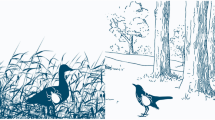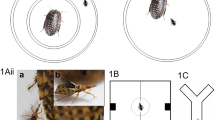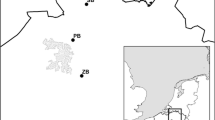Abstract
In the vicinity of Palmer Station, Antarctica, the seabird tick, Ixodes uriae, forms large aggregations under rocks at the periphery of Adelie penguin rookeries. When the adult penguins return to the rookeries at the beginning of the nesting season the ticks leave their off-host aggregation site, attach to the penguins for a period of feeding, and then subsequently return to the aggregation site. In this study, we searched for chemical cues that may be used by the ticks to locate their aggregation sites as well as cues involved in finding penguins. Tick excreta and soil extracts from beneath tick aggregations contained a pheromone that elicited assembly behavior in unfed larvae, non-fed nymphs and non-fed adults. Guanine, the major excretory product of ticks, elicited assembly behavior, thus, guanine is likely an active component involved in assembly. Non-fed stages also responded positively to penguin guano and uric acid, the primary excretory product of penguins, suggesting that uric acid and other components of penguin guano function as a kairomone used by the non-fed ticks to locate their host. After feeding, the immature ticks’ response to both the assembly and kairomones is switched off for several days, and the ticks regain responsiveness only after they have molted. Fed adult females lay eggs and die without ever regaining responsiveness. Thus, I. uriae relies on two closely related chemicals to regulate two critical aspects of its life: assembly and host-finding. Guanine and other components of tick excreta function as an assembly pheromone in promoting the formation of off-host aggregations, while uric acid and other components of penguin guano function as a kairomone used by the tick to locate its host.



Similar content being viewed by others
References
Allan SA, Sonenshine DE (2002) Evidence of an assembly pheromone in the black-legged deer tick, Ixodes scapularis. J Chem Ecol 28:15–27
Arlian LG, Vyszenski-Moher DL (1995) Response of Sarcoptes scabiei var. canis (Acari: Sarcoptidae) to lipid of mammalian skin. J Med Entomol 32:34–41
Benoit JB, Yoder JA, Lopez-Martinez G, Elnitsky MA, Lee RE Jr, Denlinger DL (2007) Habitat requirement of the seabird tick, Ixodes uriae (Acari: Ixodidae), from the Antarctic Peninsula in relation to water balance characteristics of eggs, non-fed and engorged stages. J Comp Physiol B 177:205–215
Eveleigh ES, Threlfall W (1974) The biology of Ixodes (Ceratioxides) uriae White, 1852 in Newfoundland. Acarologia 16:621–635
Gothe R (1987) Tick pheromones. Onderstepoort J Vet Res 54:439–441
Knülle W, Devine TL (1972) Evidence for active and passive components of sorption and atmospheric water vapour by larvae of the tick Dermacentor variabilis. J Insect Physiol 18:1653–1664
Lee RE Jr, Baust JG (1982) Respiratory metabolism of the Antarctic tick, Ixodes uriae. Comp Biochem Physiol 72A:167–171
Lee RE Jr, Baust JG (1987) Cold-hardiness in the Antarctic tick, Ixodes uriae. Physiol Entomol 60:499–506
Lindeboom HJ (1984) The nitrogen pathway in a penguin rookery. Ecology 65:269–277
Mangin S, Gauthier-Clerc M, Frenot Y, Gendner J-P, Le Maho Y (2003) Ticks Ixodes uriae and the breeding performance of a colonial seabird, king penguin Aptenodytes patagonicus. J Avian Biol 34:30–34
McCoy KD, Tirard C (2002) Reproductive strategies of the seabird tick Ixodes uriae (Acari: Ixodidae). J Parasitol 88:813–816
Norval RAI, Peter T, Yunker CE, Sonenshine DE, Burridge MJ (1991) Responses of the ticks Amblyomma hebraeum and A. variegatum to known or potential components of the aggregation-attachment pheromone. I. Long-range attraction. Exp Appl Acarol 13:11–18
Petney TN, Bull CM (1981) A non-specific aggregation pheromone in two Australian reptile ticks. Anim Behav 29:181–185
Samish M, Rehacek J (1999) Pathogens and predators of ticks and their potential in biological control. Ann Rev Entomol 44:159–182
Sokal RR, Rohlf FJ (1995) Biometry: the principles and practice of statistics in biology research. Freeman, San Francisco
Sonenshine DE (1991) Biology of ticks. Oxford University Press, New York
Sonenshine DE (2006) Tick pheromones and their use in tick control. Ann Rev Entomol 51:557–580
Winston PW, Bates DS (1960) Saturated solutions for the control of humidity in biological research. Ecology 41:232–237
Worland MR, Block W (2003) Desiccation at sub-zero temperatures in polar terrestrial arthropods. J Insect Physiol 49:193–203
Yoder JA, Domingus JL, Luerman GC (2003) Uric acid-induced arrestment as a possible bird host cue (kairomone) in nymphs and adults of the lone star tick, Amblyomma americanum (L.). Int J Acarol 29:399–402
Yoder JA, Ark JT, Farrell AC (2008). Failure by engorged stages to react to assembly pheromone, guanine and uric acid in the lone star tick, Amblyomma americanum. Med Vet Entomol. (in press)
Yunker CE, Peter T, Norval RAI, Sonenshine DE, Burridge MJ, Butler JF (1992) Olfactory responses of adult Amblyomma hebraeum and A. variegatum (Acari: Ixodidae) to attractant chemicals in laboratory tests. Exp Appl Acarol 13:295–301
Acknowledgments
NSF grants OPP-0337656 and OPP-0413786 funded this research. We thank the Palmer Station Research Staff for their assistance.
Author information
Authors and Affiliations
Corresponding author
Rights and permissions
About this article
Cite this article
Benoit, J.B., Lopez-Martinez, G., Philips, S.A. et al. The seabird tick, Ixodes uriae, uses uric acid in penguin guano as a kairomone and guanine in tick feces as an assembly pheromone on the Antarctic Peninsula. Polar Biol 31, 1445–1451 (2008). https://doi.org/10.1007/s00300-008-0485-1
Received:
Revised:
Accepted:
Published:
Issue Date:
DOI: https://doi.org/10.1007/s00300-008-0485-1




